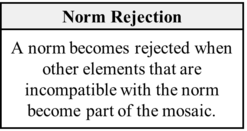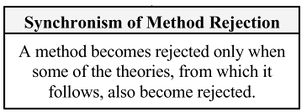Difference between revisions of "Mechanism of Method Rejection"
| (One intermediate revision by the same user not shown) | |||
| Line 25: | Line 25: | ||
|History= | |History= | ||
|Current View= | |Current View= | ||
| − | |Parent Topic= | + | |Parent Topic= |
|Related Topics=Method Employment | |Related Topics=Method Employment | ||
|Sorting Order=1200 | |Sorting Order=1200 | ||
|Page Status=Needs Editing | |Page Status=Needs Editing | ||
| − | |Editor Notes= | + | |Editor Notes= |
}} | }} | ||
{{Acceptance Record | {{Acceptance Record | ||
| Line 38: | Line 38: | ||
|Accepted From Day=1 | |Accepted From Day=1 | ||
|Accepted From Approximate=No | |Accepted From Approximate=No | ||
| − | |Acceptance Indicators=The is when the community accepted its first answer to the question, [[Method Rejection theorem (Barseghyan-2015)]], which indicates that the question is itself legitimate. | + | |Acceptance Indicators=The is when the community accepted its first answer to the question, [[Method Rejection theorem (Barseghyan-2015)]], which indicates that the question is itself legitimate. |
|Still Accepted=Yes | |Still Accepted=Yes | ||
|Accepted Until Era= | |Accepted Until Era= | ||
Latest revision as of 18:13, 22 June 2024
How do methods become rejected? What is the mechanism of method rejection?
The process of method rejection is an integral part of method dynamics. As some methods become employed by epistemic agents, other methods cease to be employed. Thus, it is important to unearth the underlying dynamics of method rejection, i.e. the mechanism that leads epistemic agents to reject their employed methods.
In the scientonomic context, this question was first formulated by Hakob Barseghyan in 2016. The question is currently accepted as a legitimate topic for discussion by Scientonomy community.
In Scientonomy, the accepted answers to the question can be summarized as follows:
- A method becomes rejected only when some of the theories, from which it follows, also become rejected.
- A norm becomes rejected when other elements that are incompatible with the norm become part of the mosaic.
Contents
Scientonomic History
Acceptance Record of the Question
| Community | Accepted From | Acceptance Indicators | Still Accepted | Accepted Until | Rejection Indicators |
|---|---|---|---|---|---|
| Scientonomy | 1 January 2016 | The is when the community accepted its first answer to the question, Method Rejection theorem (Barseghyan-2015), which indicates that the question is itself legitimate. | Yes |
All Direct Answers
| Theory | Formulation | Formulated In |
|---|---|---|
| Method Rejection theorem (Barseghyan-2015) | A method ceases to be employed only when other methods that are incompatible with the method become employed. | 2015 |
If a direct answer to this question is missing, please click here to add it.
Accepted Direct Answers
| Community | Theory | Formulation | Accepted From | Accepted Until |
|---|---|---|---|---|
| Scientonomy | Method Rejection theorem (Barseghyan-2015) | A method ceases to be employed only when other methods that are incompatible with the method become employed. | 1 January 2016 | 22 February 2024 |
Suggested Modifications
Current View
In Scientonomy, the accepted answers to the question are Synchronism of Method Rejection theorem (Barseghyan-2015) and Norm Rejection theorem (Pandey-2023).
Mechanism of Normative Theory Rejection
Norm Rejection theorem (Pandey-2023) states: "A norm becomes rejected when other elements that are incompatible with the norm become part of the mosaic."
The previous scientonomic account of transitions from the stance of employment to that of unemployment applied exclusively to methods. With Rawleigh's suggestion to expand the third law from applying to methods only to norms of all types, it became important to also have a theorem describing how norms of all types become rejected. Pandey's formulation fills this gap and stipulates that norms become unemployed when they are incompatible with other elements that enter into the mosaic.
Synchronism vs. Asynchronism of Method Rejection
Synchronism of Method Rejection theorem (Barseghyan-2015) states: "A method becomes rejected only when some of the theories, from which it follows, also become rejected."
The principle of this theorem is first introduced in Barseghyan (2015). We recall that "there are two somewhat distinct scenarios of method employment. In the first scenario, a method becomes employed when it strictly follows from newly accepted theories. In the second scenario, a method becomes employed when it implements the abstract requirements of some other employed method by means of other accepted theories. It can be shown that method rejection is only possible in the first scenario; no method can be rejected in the second scenario. Namely, it can be shown that method rejection can only take place when some other method becomes employed by strictly following from a new accepted theory; the employment of a method that is not a result of the acceptance of a new theory and is merely a new implementation of some already employed method cannot possibly lead to a method rejection."1p. 174
As per Barseghyan, it is important to note that "two implementations of the same method are not mutually exclusive and the employment of one doesn’t lead to the rejection of the other".1p. 176 Barseghyan illustrates this nicely with the example of cell-counting methods (see below). Furthermore, he writes, "an employment of a new concrete method cannot possibly lead to a rejection of any other employed method. Indeed, if we take into account the fact that a new concrete method follows deductively from the conjunction of an abstract method and other accepted theories, it will become obvious that this new concrete method cannot possibly be incompatible with any other element of the mosaic. We know from the zeroth law that at any stage the elements of the mosaic are compatible with each other. Therefore, no logical consequence of the mosaic can possibly be incompatible with other elements of the mosaic. But the new method that implemented the abstract method is just one such logical consequence".1p. 176-7
According to the synchronism of method rejection theorem, a method becomes rejected only when some of the theories from which it follows become rejected. By the method rejection theorem, a method is rejected when other methods incompatible with it become employed. By the Third Law, this can happen only when some of the theories from which it follows are also rejected.1p. 177-183
Related Topics
This question is a subquestion of Mechanism of Normative Theory Rejection.
It has the following sub-topic(s):
This topic is also related to the following topic(s):

